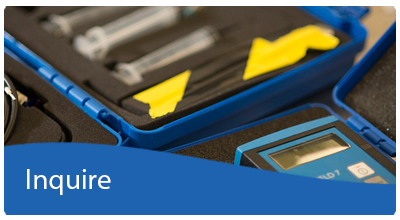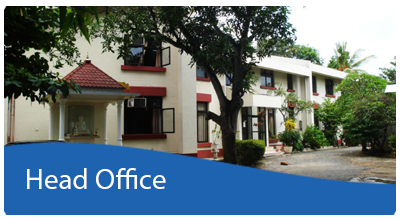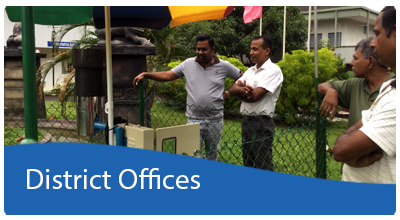As the National Focal Point for landslide risk management of Sri Lanka, National Building Research Organisation has a big role to play in reducing the risk levels of the vulnerable communities in the country. Undoubtedly, a great portion of the weight of this responisibility lies on the Landslide Research and Risk Management Division which aided by its talented staff works tirelessly for a safer country. The division has been actively involved in a number of structural and non-structural mitigation projects funded by both GOSL and foreign funding agencies like World Bank for the past decade.
Structural Mitigation Projects
Integrated Landslide Mitigation Proposal(ILMP)
In the year 2012, the Landslide Research and Risk Management Division had identified 47 critical landslides and 30 landslide affected schools which needed to be mitigated to reduce the risk of landslides on the children, residents, public and private entities, infrastructure and plantations within the districts of Badulla, NuwaraEliya, Kandy and Matale. Out of the 47 landslide sites, NBRO had prioritized 16 sites which needed urgent action for mitigation and the Integrated Landslide Mitigation Proposal (ILMP) was tabled for the Government's consideration for funding arrangements.
Technical Cooperation for Landslide Mitigation Project (TCLMP)
In the year 2013, 04 landslide affected sites, out of the 16 landslides prioritized under ILMP, had been selected by JICA for supporting the mitigation. As a result, the Technical Cooperation for Landslide Mitigation Project (TCLMP) was commenced on October 01, 2014. Under the TCLMP, two natural landslides in Udamadura in Nuwara Eliya District, and in Badulusirigama in Badulla District and a rock-fall threat in Alagumale in Matale District were selected as pilot sites. The advanced technologies practiced in Japan and other developed countries have been utilized in the proposed mitigation activities. From the three sites, Udamadura and Alagumale were handed over after the successful completion of mitigation work in March 2017 while post-monitoring activities are being carried out at the Badulusirigama site.
Climate Resilience Improvement Project (CRIP)
School Protection Program
Also in the year 2013, funding arrangements with the World Bank were negotiated by the Government of Sri Lanka, and as a result, mitigation of landslides in 18 landslide affected schools in Kandy District was implemented under the World Bank funded Climate Resilience Improvement Project (CRIP). The 18 landslide affected schools were selected out of the 30 landslide affected schools listed in ILMP tabled in the year 2012. The School Protection Program is a $7 million investment on 18 schools from Kandy district identified to be highly vulnerable to landslides threat (benefiting approx. 30,000 students). This project is expected to address the occasional interferences to the education these schools have to face annually during the rainy seasons. 11 schools out of the selected 18 schools under the School Protection Program have been tendered and awarded. Construction works at these schools are currently under progress while the remaining schools being at the tender evaluation process are to be awarded to prospective bidders shortly within the coming months.
Road Project
In addition, landslide mitigation work are being carried out at the following location
- Rectification work in Kandy- Mahiyangana Road
- Rectification work in Kandy- Mahiyangana Road
- Rectification work in Kandy- Mahiyangana Road
- Rectification work in Hakgala
- Rectification work in Ginigathhena
Other Mitigation Projects
In the years 2009, and 2010, NBRO implemented four major structural mitigation projects for mitigating Peredeniya, Padiyapelella, Mahawewa and Garandiella landslides.
Mitigation of Peradeniya Landslide
Peradeniya landslide is located at Peradeniya town, by the Colombo Kandy main road. This landslide occurred in November 2006 destroying a few boutiques in the town and interrupting road traffic for weeks. Peradeniya is the gateway to the historical city of Kandy. The Government of Sri Lanka allocated Rs. 102 Million to mitigate this landslide for the benefit of the users of Colombo Kandy main road and the dwellers and commuters to the Peradeniya town. The mitigation work completed in June 2013.
 |
 |
|
| Mitigation Activities in Progress |
The mitigation work started in January 2009 by the Landslide Research and Risk Management Division (LRRMD) by applying structural methods such as construction of retaining structures, construction of surface drainage. In addition, monitoring of the site for any possible slope movements were continuously carried out.
The mitigation of Padiyapelella landslide was successfully completed in March 2013 and handed over to the community on Saturday 8th June 2013 in a ceremony under the distinguished patronage of Hon. Mahinda Amaraweera, Minister of Disaster Management and Hon. C B Rathnayake, Minister of Private Transport Services.
Mitigation of Padiyapalella Landslide
Padiyapalella landslide is located at Padiyapalella town, by the main road of WalapaneHanguranketha. The landslide occurred on 12th January 2007 destroying more than three houses and interrupting road traffic. Padiyapalella is the main town in between Hanguranketha and Walapane and the main access to Maturata and Mandaramnuwara also goes through Padiyapalella. The Government of Sri Lanka allocated Rs. 51.38 Million for mitigation of this landslide for the benefit of the business community, road users, dwellers and commuters to the Padiyapalella town.
 |
 |
The mitigation work started in January 2009 by the Landslide Research and Risk Management Division (LRRMD) by applying structural methods such as construction of retaining structures, construction of surface drainage. In addition, monitoring of the site for any possible slope movements were continuously carried out.
The mitigation of Padiyapelella landslide was successfully completed in March 2013 and handed over to the community on Saturday 8th June 2013 in a ceremony under the distinguished patronage of Hon. Mahinda Amaraweera, Minister of Disaster Management and Hon. C B Rathnayake, Minister of Private Transport Services
Mitigation of Mahawawa Landslide
Mahawewa landslide is located at Kumbalgama in NuwaraEliya district. Due to the heavy rain on 12th Jan 2007, Mahawewa landslide occurred damaging more than 65 houses in the down slope area. Therefore, all the villagers had been evacuated from their existing dwellings. After the initial incident, with the heavy rains in early 2011, this area showed symptoms of gradual movements. The WalapaneHanguranketha main road, and the KeerthiBandaraVidyalaya, are situated at the extreme down slopeof this landslide, and are at the highest risk, if the landslide is reactivated. As part of the mitigation process, with the support from the Sri Lankan government and Japanese International Cooperation Agency (JICA), LRRMD commenced monitoring of this landslide in the year 2009.
Installation of automatic rain gauges, extensometers and strain gauges and monitoring the surface movement to study the controlling characteristics of the landslide are completed under the JICA assistance. The estimated cost of proposed mitigation activities is Rs. 441 Million for which the Government’s support is expected.
 |
 |
Mitigation of landslide threat in Badulla District
NBRO has realized that the landslide frequency has been increased in the Badulla district with the increases of human activities and unplanned developments in hilly areas. Therefore, NBRO has implemented a non-structural mitigation project for the Badulla district to reduce the landslide risk by introducing appropriate land use practices. The project will be implemented in association with the Land Use Policy Planning Department (LUPPD) of Sri Lanka. LUPPD is to provide updated maps of land use within the district and NBRO will evaluate the landslide risk.
As part of this project landslide hazard potential evaluation in Uva Paranagama Divisional Secretariate and in Haputale and Bandarawela Divisional Secretariates are carried out. A set of appropriate land use techniques and guidelines for building and other construction will be prepared as the primary out come and the techniques and guidelines will be implemented through LUPPD. The Government of Sri Lanka has allocated Rs. 3.0 M for this mitigation projects.
 |
Mitigation of subsidence observed within Matale District
Unusual behaviors such as cracking of a large number of houses, appearance of sudden ground subsidence and appearance of a large number of springs off the ground had abruptly been occurred in a wide area close to the Matale town in the year 2006. Cracking of houses had been distributed along a specific zone starting from Ukuwela area to Palapathwala through Matale town and the situation was considered as disastrous. About 3000 affected houses were identified within 24 GramaNiladhari divisions of Matale and Rattota divisional secretariats during the project.
After a detailed study and preparation of subsidence hazard zonation maps NBRO has now implemented a non structural mitigation project in the affected area for preparation of guidelines for building and surface water drainage and conducting awareness programmes for educating the communities to be safe concern and on importance on following the proposed guidelines. The total estimated cost of the project is Rs. 2.0 M.
 |
 |
Mitigation of Garandiella Landslide
Garandiella landslide is located by the 41st kilometer post on NuwaraEliya-Gampala main road in Kothmale Division. Mitigation of this landslide was commenced on Auguat 02, 2011 for reducing the landslide risk on the users of the NuwaraEliya-Gampala main road, Kothmale reservoir, 230 families living in the RambodaGramaSevaWasam in Kothmale Division and the built environment in the Kothmale town.
Geological and geotechnical investigations which consists the first stage of mitigation activities were completed by the end of the year 2011 and based on the results of those investigations, appropriate mitigation measures have been designed and implemented in the year 2012. The total estimated cost of mitigating Garandiella landslide is 90 Million which is invested by the Government of Sri Lanka through the District Secretariat of NuwaraEliya.
 |
 |
| Resistivity testing at the site | Director General is on an inspection tour |
Mitigation of Galabada Landslide
Galabada landslide is located within the GallellaGramaSeva Division of the Ratnapura Divisional Secretariat. 10 families living in the down slope area, shops, Rathganga (Punch Dambadiva) temple, Galaboda estate, RatnapuraWewelwatta main road and the users of this road are at the risk of being affected by this landslide. In March 2010, with the financial assistance of JICA, LSSD implemented monitoring and mitigation of Galaboda landslide. In December, 2011, for monitoring the surface movements, and to study the controlling characteristics of the landslide, slope movement monitoring instruments such as automatic rain gauges, extensometers, strain gauges and piezometers were installed.
In addition, two boreholes were drilled up to 40 m depth and the impact on landslide due to the properties of underneath soil layers were analyzed.
 |
 |
| Newly formed cracks | Borehole drilling at Galaboda |
Mitigation of New Burgh Landslide
Based on the recommendations provided by LSSD, mitigation of NewBurgh Landslide in Badulla was implemented as a community based mitigation (CBDM) project which is laboured by the state community living in the toe area of the landslide. With the maximum coorporation by the estate management, the project is financially supported by USCOD, an NGO working in the Badulla district. The mitigation activities were commenced with cleaning existing drains and drainage paths on the body of the destabilized slope, in December 2010. During the period of down pours between December 2010 to February 2011,Badulla area was affected by a large number of landslides within the proximity, but with only a few cracks on the referred site. Motivated by this favourable situation, the remaining mitigation activities were commenced on 16th July, 2011. Landslide risk on estate communities, a school and infrastructure will be reducded by this mitigation.
Mitigation of Malhewa Rockfall
The scientists of NBRO has successfully mitigated the rock fall threat in Ambahela, Hunuketapitiyakanda located in MalhewaGramaSevaWasam in Kothmale Administrative Division. Due to this rockfall, the residents in the down slope area of Hunuketapitiyakanda and the users of Kothmale, Thawalamthenna - Pundaluoya road were frequently at risk for a long time.
In addition to the removal of unstable rock boulders in up slope area, NBRO scientists has applied mitigation structures consisting trenches, bunds and fences. The mitigation activities which were commenced in December 2011 and completed in March 2011 has significantly reduced the rockfall threat in this area.
 |
 |
| Mitigated Malhewa Rock Fall |
Non-structural Mitigation Projects
Two non-structural mitigation projects were also implemented in Badulla and Matale districts to reduce the landslide risk within those districts by introducing appropriate land use practices in year 2012. In addition, a community based awareness and early warning project has been implemented in year 2016.
























